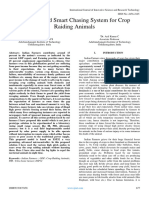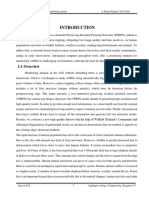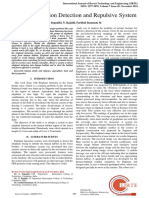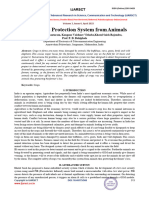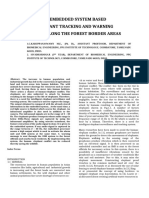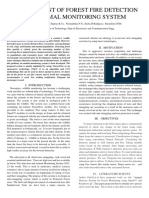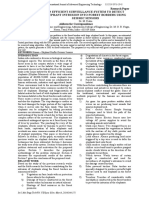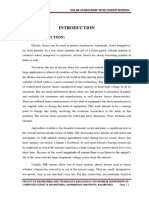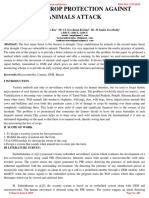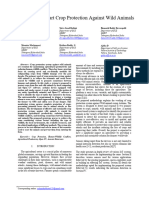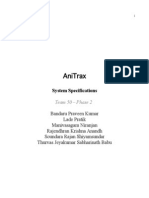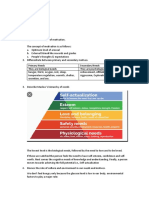0 ratings0% found this document useful (0 votes)
8 viewsCrop Protection and Monitoring From Animal Attacks Using Iot Sollutions 2
Crop Protection and Monitoring From Animal Attacks Using Iot Sollutions 2
Uploaded by
iimagine915The document discusses using IoT solutions to protect crops from animal attacks. It describes surveying a village called Katli in India that has issues with wild animals destroying crops. An acoustic repellent system using an IR camera and CNN model was created to identify animals like deer and boars and generate frequencies to deter them from farms without endangering crops or people.
Copyright:
© All Rights Reserved
Available Formats
Download as DOCX, PDF, TXT or read online from Scribd
Crop Protection and Monitoring From Animal Attacks Using Iot Sollutions 2
Crop Protection and Monitoring From Animal Attacks Using Iot Sollutions 2
Uploaded by
iimagine9150 ratings0% found this document useful (0 votes)
8 views7 pagesThe document discusses using IoT solutions to protect crops from animal attacks. It describes surveying a village called Katli in India that has issues with wild animals destroying crops. An acoustic repellent system using an IR camera and CNN model was created to identify animals like deer and boars and generate frequencies to deter them from farms without endangering crops or people.
Original Description:
Journel paper
Original Title
CROP PROTECTION AND MONITORING FROM ANIMAL ATTACKS USING IOT SOLLUTIONS 2
Copyright
© © All Rights Reserved
Available Formats
DOCX, PDF, TXT or read online from Scribd
Share this document
Did you find this document useful?
Is this content inappropriate?
The document discusses using IoT solutions to protect crops from animal attacks. It describes surveying a village called Katli in India that has issues with wild animals destroying crops. An acoustic repellent system using an IR camera and CNN model was created to identify animals like deer and boars and generate frequencies to deter them from farms without endangering crops or people.
Copyright:
© All Rights Reserved
Available Formats
Download as DOCX, PDF, TXT or read online from Scribd
Download as docx, pdf, or txt
0 ratings0% found this document useful (0 votes)
8 views7 pagesCrop Protection and Monitoring From Animal Attacks Using Iot Sollutions 2
Crop Protection and Monitoring From Animal Attacks Using Iot Sollutions 2
Uploaded by
iimagine915The document discusses using IoT solutions to protect crops from animal attacks. It describes surveying a village called Katli in India that has issues with wild animals destroying crops. An acoustic repellent system using an IR camera and CNN model was created to identify animals like deer and boars and generate frequencies to deter them from farms without endangering crops or people.
Copyright:
© All Rights Reserved
Available Formats
Download as DOCX, PDF, TXT or read online from Scribd
Download as docx, pdf, or txt
You are on page 1of 7
CROP PROTECTION AND MONITORING FROM
ANIMAL ATTACKS USING IOT SOLLUTIONS
Nandhini GS,
Assistant Professor,
Kaviyarasu M,
Electronics and
Saminathan K,
Electronics and communication
Aakash K,
Electronics and communication
Electronics and communication communication Engineering Engineering
Engineering Engineering Shree Venkateshwara Hi-Tech Shree Venkateshwara Hi-Tech
Shree Venkateshwara Hi-Tech Shree Venkateshwara Hi- Engineering College, Gobi, Engineering College, Gobi,
Engineering College, Tech Engineering College, Erode-638455, Erode-638455,
Gobi,Erode-638455 Gobi,Erode-638455, Tamil Nadu, India Tamil Nadu, India
Tamil Nadu, India Tamil Nadu, India
nandhinigsece@gmail.com mkarasu8820@gmail.com karthiksaminathan392@gmail.com aakashaakash9229@gmail.com
area could have disastrous effects for the nation.
Abstract-We offer various perspectives on
A few major issues impeding the development
the problem of wild animals destroying crops.
The impacted farmers around the world are
really concerned about this, and it causes them a
great deal of social and financial hardship. An
investigation was carried out at Katli village,
Rupnagar, (India), to ascertain the history of this
issue. The primary goal of the ongoing research
is to create a tool that will deter wild animals
from damaging crops by directing them away
from farms without endangering the crops
themselves. In this regard, an IR camera and a
convolutional neural network (CNN)-based
machine learning model have been used in the
creation of an Acoustic Repellent System to
recognize target species, including deer, wild
boar, and nilgai. A camera and frequency
generator have been incorporated into a
Raspberry Pi (Rpi) module to identify various
of agriculture in the nation are irregular rainfall
animals and generate appropriate frequencies
patterns, bad weather, and overuse of fertile
that deter them from visiting the farms of
land. Worse still, wildlife damage to crops is
interest. Furthermore, the suggested solution's
making matters worse. Animal habitats are
architectural features have been thoroughly
disappearing as a consequence of the
described. Finally, the suggested solution's
population's rapid deforestation. In pursuit of
possible effects have been examined.
food and habitat, this is forcing wildlife to
I. INTRODUCTION trespass across human-populated regions,
particularly the agricultural fields. Due to its
extensive forest cover, India's agricultural lands
Three fourth of Indians work in agriculture as are more vulnerable to assaults by wild animals.
their primary occupation. It is the Indian
economy's lifeblood. Any significant issue in These days, this is becoming a big deal in a lot
this of places worldwide. For example, in Tanzania
[1], the annual loss resulting from crop
destruction for villages bordering forests is
around 250% of the loss experienced by other
villages outside protected forest areas.
Elephants, deer, nilgai (blue bulls), tigers, foxes, Convolutional neural networks (CNNs) have
and other wild animals are regularly spotted in been extensively used in computer vision
the country's agricultural areas [2]. These technologies since their remarkable success in
creatures put the farmers' lives and their crops in the 2012 Large Scale Visual Recognition
grave danger; they even endanger their own Challenge ImageNet [8]. A plethora of CNN
lives. In the paper, we have put up a solid and models have been put out with the goal of
secure method to address this issue. outperforming conventional computer vision
approaches in solving intricate picture
identification problems faster and with more
accuracy. For the same reason, we turned to
II. RELATED WORK
CNN. Our method makes use of an RPi
microcontroller module, which has greater
There have been a few contributions to the memory and performs far better than an
solution of this problem thus far. Research on Arduino. In order to maximize performance and
Internet of Things-based strategies to stop prevent alarming humans and domestic animals,
animals from entering fields has been we have additionally engineered our system to
conducted. Using a PIR (Passive Infrared) generate frequencies specific to each species.
sensor to identify the animals, one method uses
ultrasonic repellers [5]. After recognizing the
animal, it triggers the driver, which then emits
ultrasonic waves at a frequency of 20 to 40 kHz III. SURVEY
to terrify it and send it back into the forest. But Survey and Data Collection Method
because this PIR sensor can't distinguish
between multiple animals at once, the device We acquired the panchayat committee's and
always outputs the predetermined frequency for CENSUS 2011 [9] data for Katli village's
the intended animal, which can be unsettling and fundamental information. To examine the issue
startling for both humans and domestic animals. more closely, we went to a few key areas. To
A WSN (Wireless Sensor Network) system gather the village's ground report and obtain
positioned in nodes at key points throughout the precise, in-depth information on the problem, we
field was the basis of another suggested method got in touch with the residents. In our poll, we
[6]. The field's perimeter is continuously spoke with over 70% of farming households and
scanned by a variety of lasers and sensors, inquired about the losses they suffer annually as
including photo detector cameras, to look for a result of wild animals. We also asked about the
signs of incursion. Then, a mix of buzzers and effectiveness of their customary animal-
flashers is used to deflect the animals. The repelling techniques, pertinent governmental
maximum amount of crop destruction that this regulations, and how these tackle their issue.
technique could prevent was 5%. Another study
Principal Discoveries
detected the animals and scared them away
using ultrasonic sensors and the ORB algorithm After doing the survey, we found that there is a
[7]. Since each study carried out here had a significant issue with wild animals destroying
distinct goal and set of optimum parameters crops in and around the Katli village. The Indian
based on its needs, each study's functional state of Punjab has the village of Katli in the
efficacy and efficiency differs. Advancements in Rupnagar district. It lies 43 miles from
Machine Learning (ML), particularly in deep Chandigarh, the state capital, and 6 km north of
learning, a branch of ML, have expanded the Rupnagar. Fig. 2 shows a view of the village's
automation potential across multiple domains. terrain. The similar issue is present in Sadabarat,
Among them is, of course, agriculture. the community adjacent to Katli. Every year,
over half of the crops are destroyed by wild because they are prone to being broken by
animals such as deer, barasingha, wild boar, and animals or by environmental factors. Figure 3
nilgai. While barasingha, nilgai (blue bull), and depicts a damaged fence that was broken by
deer primarily damage rice, potatoes, and animals two years ago, but the villagers lacked
sugarcane, wild boars eat all kinds of crops. .. the money to fix it. In the course of our survey,
Animals typically enter the community from the we also discovered that both humans and
Sadabarat village, where the fence is broken as a animals could not survive an electrified fence.
result of inadequate maintenance, according to
our geographical assessment of the village. The
fact that the woodland is not entirely fenced off
from all sides allows the animals to enter the
fields through a number of points, as shown on
the map in Figure 2. A point of reference is the
open space next to St. Carmel School.
2)Organic Repellents Farmers also employ a
variety of natural repellents, such as smoke, fish
or garlic emulsion, beehive fence, and other
repellents based on eggs, although none of these
are very effective over the long run.
Furthermore, there are negative impacts
associated with each of these solutions.
Through our surveys, we also obtained some
insights on the steps taken by the villagers to tackle 3) Employing Security Guards
this wild animal problem. Some of the methods that Numerous villagers have constructed hut-like
have been put into practice by them are as follows:
structures in the middle of the farm, as seen in
1) Fencing for agriculture For years, fencing has
Fig. 4. These are employed for nighttime field
been a well-liked and reliable method of keeping
security. Rich farmers may find this to be a
wild animals at bay. Nonetheless, the
workable option, but impoverished farmers
government frequently regulates the
cannot afford a watchman, and watchmen face
construction of fences as a protective measure.
harsh and cold winter conditions. Even animal
specified types of fences may be restricted or
attacks against watchmen are a possibility.
used only in specified situations by municipal
and governmental entities. For this reason, it's
crucial to review the legal rules before selecting
a fence. The fence's material determines its
quality.
Some animals might not even be able to get
through these fences because, for example,
barasinghas can jump up to two meters. In
certain situations, building fences of such
heights could not be practical or cost-effective.
Furthermore, fences may not provide protection
4) Shooting Animals with Approval from the
Government Since poaching first seemed to be A. Electronic Parts :
the most practical remedy, the authorities ● Raspberry Pi 3B
allowed farmers to hunt the animals that were
● LiPo batteries
encroaching on their farms. This policy states
that one can only hunt animals if they intrude ● Raspberry Pi Infrared Camera
into their field and they have a government-
issued authorization. The poacher is not ● Ultrasonic Frequency Generator
protected by this legislation, though, if they are ● Module Casing
killed in their native habitat. In addition, the
legal quirk is that the farmer must possess both a B. Finding the Animals :
firearm license and the necessary expertise to A high-resolution Infrared Night Vision camera
handle it securely. The possibility of animal would pick up movement and photos of the
vengeance, such as that from elephants or wild approaching animal. This will assure security at
boars, is always present. night, in inclement weather, and in limited
visibility, even in the absence of humans. The
There are currently no long-term, financially Raspberry Pi (Rpi 3B), a microcontroller that
viable answers to this issue. Keeping in mind serves as the coordinator and overall module
everything said above, we suggest that the issue brain, will receive the video straight from the
be resolved by developing a long-term, practical camera, which will record it continually. The
solution that spares the crops and doesn't Rpi will begin to spontaneously record frames at
endanger the animals. predetermined intervals. The Python OpenCV
library will be used to capture and process the
First, the suggested system will identify the frames.
species of animal that occurs to be inside its The machine learning model will then be fed the
detection range. This device will sense its collected frames, and it will use them to forecast
environment with an infrared camera and use the correct animal with a high likelihood of
computer vision to interpret images. Using a accuracy.
variety of machine learning methods, it will
examine the information and determine which How to close the gap between two frames that
specific animal is present. The Raspberry Pi must be recorded is the challenge. The amount
microcontroller serves as a coordinating tool. A of data generated and the computing expense
frequency generator will emit the animal- would be enormous if we attempted to record
corresponding frequency waves to scare off the every frame. Furthermore, since the animal will
target animal if it detects the animal and sends a undoubtedly be filmed for a few seconds in the
positive signal. It would depart the sensor's movie (if it is inside the camera's field of view),
coverage area since it couldn't stand the high- there is no need to do this. However, if we
pitched sound [5]. maintain a large distance, the animals might
escape without being noticed. We came to the
IV. SYSTEM ARCHITECTURE conclusion that a frame capture rate of one
frame per second to one frame every ten seconds
would be adequate after researching the mobility
We now talk about the system architecture we
of wild animals and doing some thinking. Every
have presented. First, we enumerate the different
five seconds would be a good interval to take a
hardware parts that the suggested module will
picture.
have.
C. Predictive Machine Learning Model for rename the training dataset. A categorical
Animals matrix is then used to represent that data. Prior
The acquired frames will be utilized to forecast to supplying the dataset to the model, duplicates
which wild animal, if any, is present in the and watermarked photos were eliminated from
vicinity. A machine learning (ML) model built the image collection. The dataset was then
on the Convolutional Neural Network (CNN) prepared and divided into training and testing
sets. The model consists of four convolutional
architecture will be used to make the prediction.
layers, each of which comprises a 2 x 2 pooling
A popular deep learning technique for image
layer that performs max-pooling and an
recognition is the CNN framework. activation function of the Rectified Linear Unit.
Convolutional Neural Networks employ the The output is a layer with the activation
technique of first extracting simple patterns from function "Softmax," and it has one dense layer
with a Rectified Linear Unit as the activation
each layer of the image, then integrating those
function. The model was compiled with ‘Binary
patterns to determine the image's complex Cross entropy' as the loss function and ‘Adam'
features. We use a filter matrix to operate the as the optimizer.
image in each layer to apply convolution. After
that, a process known as pooling is used to
extract a specific value from a designated sub-
part of the image that reflects the entire subpart.
Consequently, the features get coarser while the
dimension gets smaller significantly, making
computation easier and preventing overfitting in
the model. An activation function is used to
determine the weights of the neurons in each
layer. It attempts to minimize the error in the
training dataset by varying the weight of each
neuron through forward and backward
propagations.
The main parameters are the total number of
layers, the number of neurons in each layer, the D. Repelling detected animals with sound:
size of the filter matrix, the kind of activation The Raspberry Pi will communicate with the
function, and the form of the pooling layer. The Ultrasonic Frequency generator by sending a
values of these parameters are selected based on signal based on the animal that our model has
the applications, input parameters, and the predicted. We would employ an ultrasonic
programmer's expertise. repellant that has a frequency range of 15 to 65
In Jupyter Notebook, we trained the CNN-based kHz. With a 110 degree width, it offers a good
machine learning model (see Fig. 6). The 10 to 15 meter audible range. For greater
training dataset was sourced from the Kaggle efficacy, we would employ an amplifier to
database [12], Shutterstock [11], and Google extend that auditory range even further. The Rpi
Images. More than 10,000 photos of various will transmit an instruction to create a specific
animals, including blue bulls, hens, boars, range of frequencies corresponding to the
canines, etc., were included in the dataset. predicted animal once it has identified one. Our
Additionally, a training set consisting of 80% of review of the literature indicates that in addition
all photos was created from the dataset. Twenty to generating a significant acoustic diversity,
percent more were kept in the testing dataset. wild animals have evolved to be sensitive to
Since each image needs to specify which animal
detecting ultrasonic sound frequencies [13]. As a
it represents, a Python script was then used to
result, almost every animal has a certain
frequency range that it can hear and a frequency their safety and security. Compared to previous
range that irritates it; the majority of these methods, it requires essentially no human
frequencies are far above what humans can hear. intervention, which means that it will reduce the
The target animals' hearing frequencies fall workload for humans. There will be restrictions
within the following range: on the careless killing of wild animals in the
cause of security and safeguarding human rights.
●Nilgai (blue bull) and deer: 33 Hz – 50 KHz
The amount of money set aside for the
●Wild Boar (Sus Scrofa): 250Hz – 40 KHz
conservation of wildlife can be reduced by the
E. Networking via the Cloud : government. This will guarantee that animals are
Using a Wi-Fi connection, the animal treated humanely, promoting ecological balance
recognition module will routinely communicate and stability. We believe that the road to
the data over the cloud. A computer running an sustainable development can be paved by these
Amazon/Microsoft cloud instance will make up initiatives.
the cloud configuration. The shared data will be
Mapping to Large scale: Should this approach
used to examine wild animal behaviors and
prove to be practically effective, it will not only
patterns. If there are any mistakes, we can see
address the problem for the Katli village but also
them, fix them, and get better outcomes.
have potential benefits in other regions of the
F. The entire module's mechanical design nation. We can communicate data across various
We created the outer casing/box that could locations to boost the system's efficiency after it
house all the hardware and offer protection from is widely implemented across the nation.
external disturbances based on the standard
dimensions and shapes of all the hardware VI. CONCLUSION
components. We created a computer-aided Many farmers are being forced to give up
design (CAD) model of the casing to provide farming since the issue of wild animals invading
greater clarity on the assembly (see Fig. 7). agricultural areas has lasted for decades and
neither the government nor the communities
V. POSSIBLE IMPACT have been able to find a satisfactory solution.
We have described in this study an integrated
By maintaining the ecosystem's balance and Internet of Things (IoT) strategy for smart
safeguarding the fields, our work benefits a agriculture that is based on open source
variety of stakeholders. technologies and low power devices. The
A notable decrease in crop damage caused by creation of a monitoring and repelling system
wild animals will coincide with an increase in for crop security against animal attacks is the
total crop productivity. Better living conditions aim of this project. Our theoretical model with
will result from a direct increase in the farmers' detailed system architecture has been elucidated,
per capita income. With more money in their which has an accuracy of more than 73%. In our
pockets, individuals may choose to upgrade the future work, we will extend the current
technologies on their farms and increase functionalities of our system and investigate the
revenue. As a result, a little action can restart a on-ground accuracy. We will then utilize the
process that will strengthen the nation's feedback to develop a more robust product. The
economy. product is slated to have a huge impact on the
lives of affected farmers in terms of economic
and social benefits.
Enhance quality of life: In addition to
addressing the issue of crop destruction, our VII. FUTURE WORK
suggested strategy will lessen the likelihood that The work on the assembly of the module and its
wild animals will attack the villagers, protecting integration with the hardware is in progress to
make the system ready to be deployed. [7] A. Sharma, T. Chaudhary and N. R.
Subsequently, this system will be implemented Chauhan, “Design and Simulation of
in the agricultural fields of Katli village after Automated Sound System to Protect
initial checks to verify the hypothesis and the Agriculture Farms”, International
accuracy of our proposed solution. With time, Journal of Advanced Research in
we will use the accumulated data to optimize our Electrical, Electronics and
Instrumentation Engineering, 2017.
CNN model and hence, improve its accuracy.
[8] L. Fei-Fei, J. Deng, and K. Li,
VIII. ACKNOWLEDGMENT “ImageNet: Constructing a large-scale
image database,” Journal of Vision, vol.
The survey of the village would not have been 9, no. 8, pp. 1037–1037, 2010.
possible without the continuous guidance and [9] “Katli Population - Rupnagar, Punjab,”
enthusiasm of Dr Devaraj. P. (Asst. Prof., IIT Katli Village Population - Rup Nagar
Ropar). We are also indebted to Ashank, Jatin - Rupnagar, Punjab.
Garg (B. Tech students, IIT Ropar) and Mansi [Online]. Available:
(PhD student, IIT Ropar), without whom, it https://www.census2011.co.in/data/villa
would be difficult to complete our survey. ge/38644-katli-punjab.html. [Accessed:
10-May-2019].
IX. REFERENCES [10] P. Simard, D. Steinkraus, and J. Platt,
“Best practices for convolutional neural
networks applied to visual document
[1] M. Angela, N. Julius, N. Janemary, and
analysis,” Seventh International
R. Eivin, “The impact of crop raiding by
Conference on Document Analysis and
wild animals in communities
Recognition, 2003. Proceedings.
surrounding the Serengeti National
[11] Nilgai Images, Shutterstock.com,
Park, Tanzania,” International Journal of
Biodiversity and Conservation, vol. 6, March 2020 [Online]. Available:
no. 9, pp. 637–646, 2014. https://www.shutterstock.com/search/nil
gai
[2] A. Veeramani, E. A. Jayson, “A survey
[12] Animals-10 dataset, Kaggle.com
of crop damage by Wild Animals in
Kerala”, The Indian Forester 1995. (Google Images) - Corrado Alessio,
March 2020. [Online]. Available:
[3] A. Sood, “Wild animals give Punjab
https://www.kaggle.com/alessiocorrado
farmers sleepless nights,” The Tribune,
99/animals10.
Nov. 24, 2014.
[13] B. D. Charlton, M. A. Owen, and R. R.
[4] Jayson, E. A., “Assessment of crop
Swaisgood, “Coevolution of vocal
damage by wild animals in Trichur
signal characteristics and hearing
District, Kerala.” No. 491, KFRI
sensitivity in forest mammals,” Nature
Research Report, 2012.
Communications, vol. 10, no. 1, 2019.
[5] S. Giordano, I. Seitanidis, M. Ojo, D.
[14] R. S. Heffner and H. E. Heffner,
Adami, and F. Vignoli, “IoT solutions
“Hearing in domestic pigs (Sus scrofa)
for crop protection against wild animal
and goats (Capra hircus),” Hearing
attacks,” 2018 IEEE International
Research, vol. 48, no. 3, pp. 231– 240,
Conference on Environmental
1990.
Engineering (EE), 2018.
[6] M. B. H., D. Janeera, and A. K. A.g,
“Internet of Things based Wild Animal
Infringement Identification, Diversion
and Alert System,”2020 International
Conference on Inventive Computation
Technologies (ICICT), 2020.
You might also like
- A.R Desai Rural Sociology in India PDFDocument755 pagesA.R Desai Rural Sociology in India PDFAkshada100% (3)
- Accounting Policies and Procedures ManualDocument9 pagesAccounting Policies and Procedures ManualKhints EttezilNo ratings yet
- A Review On Animal Detection and Classification Using Computer Vision Techniques: Scope For Future Enhancement To ApplicationDocument6 pagesA Review On Animal Detection and Classification Using Computer Vision Techniques: Scope For Future Enhancement To Applicationbalakrishnak eceNo ratings yet
- Camera Vision Based Animal Beat Back System For Agriculture Using Machine LearningDocument9 pagesCamera Vision Based Animal Beat Back System For Agriculture Using Machine LearningRaheem BaigNo ratings yet
- Ijirt160919 PaperDocument5 pagesIjirt160919 Paperjoel mshanaNo ratings yet
- Mini Batch-08 DocumentDocument40 pagesMini Batch-08 DocumentBollam Pragnya 518No ratings yet
- Esp-32 Based Smart Chasing System For Crop Raiding AnimalsDocument9 pagesEsp-32 Based Smart Chasing System For Crop Raiding AnimalsInternational Journal of Innovative Science and Research TechnologyNo ratings yet
- Iot Forest Monitoring SystemDocument44 pagesIot Forest Monitoring Systempswathip.2001No ratings yet
- IJCRT2205118Document8 pagesIJCRT2205118joel mshanaNo ratings yet
- Animal Detection and Prevention in Agri Field Using IotDocument36 pagesAnimal Detection and Prevention in Agri Field Using IotNexgen TechnologyNo ratings yet
- Automated Wild-Animal Intrusion Detection and Repellent System Using Artificial Intelligence of ThingsDocument6 pagesAutomated Wild-Animal Intrusion Detection and Repellent System Using Artificial Intelligence of ThingsSiva ForeviewNo ratings yet
- Ext 86507Document7 pagesExt 86507joel mshanaNo ratings yet
- Govt. Polytechnic College Perinthalmanna: Department of Mechanical EngineeringDocument23 pagesGovt. Polytechnic College Perinthalmanna: Department of Mechanical Engineering22-Mohammed Finan k100% (1)
- Smart Crop Protection System From Living Objects and Fire Using ArduinoDocument5 pagesSmart Crop Protection System From Living Objects and Fire Using Arduinovaibhav tambe100% (1)
- Elephant Intrusion Detection and Repulsive System: N. Suganthi, N. Rajathi, Farithul Inzamam MDocument4 pagesElephant Intrusion Detection and Repulsive System: N. Suganthi, N. Rajathi, Farithul Inzamam MSanketh ReddyNo ratings yet
- Automated Field Security: AbstractDocument8 pagesAutomated Field Security: AbstractAna johnNo ratings yet
- Computers and Electronics in AgricultureDocument9 pagesComputers and Electronics in AgricultureSanthana KrishnanNo ratings yet
- Design and Implementation of An Advanced Security System For Farm Protection From Wild AnimalsDocument5 pagesDesign and Implementation of An Advanced Security System For Farm Protection From Wild AnimalsGRD JournalsNo ratings yet
- Smart Crop Protection System From Animals: M. Jaya Prabha, R. Ramprabha, V. Vasu Brindha, C. Asha BeaulaDocument4 pagesSmart Crop Protection System From Animals: M. Jaya Prabha, R. Ramprabha, V. Vasu Brindha, C. Asha BeaulaYash ChNo ratings yet
- SSRN Id3563395Document3 pagesSSRN Id3563395Nicko Samar IndicoNo ratings yet
- SnakeDocument7 pagesSnakeGaming cornerNo ratings yet
- Comparative Analysis On Existing Animal Intrusion Detection SystemDocument7 pagesComparative Analysis On Existing Animal Intrusion Detection SystemUGCJOURNAL PUBLICATIONNo ratings yet
- Iot-Based Wild Animal Intrusion Detection System: Prajna. P Soujanya B.SDocument3 pagesIot-Based Wild Animal Intrusion Detection System: Prajna. P Soujanya B.SSanjay Sivakumar SanjayNo ratings yet
- Wild Animals Intrusion Detection Using Deep Learning TechniquesDocument7 pagesWild Animals Intrusion Detection Using Deep Learning Techniquesdhirenraja777No ratings yet
- Forest 4.0: Digitalization of Forest Using The Internet of Things (Iot)Document13 pagesForest 4.0: Digitalization of Forest Using The Internet of Things (Iot)Reshma K K100% (1)
- Paper 9421Document16 pagesPaper 9421deekshithpalisettyNo ratings yet
- Animal Intrusion Detection Using ESP32 Cam and Open CVDocument4 pagesAnimal Intrusion Detection Using ESP32 Cam and Open CVInternational Journal of Innovative Science and Research TechnologyNo ratings yet
- Protection of Agricultural Lands From Animal Intrusion Through A Smart RouteDocument5 pagesProtection of Agricultural Lands From Animal Intrusion Through A Smart RouteTanmayiNo ratings yet
- Embedded JournalDocument11 pagesEmbedded JournalSivaNo ratings yet
- Arduino Controlled Wild Animal Repellent System For Use in FarmingDocument4 pagesArduino Controlled Wild Animal Repellent System For Use in FarmingEditor IJTSRDNo ratings yet
- Development of Forest Fire Detection and Animal Monitoring System 122222Document3 pagesDevelopment of Forest Fire Detection and Animal Monitoring System 122222neelambikas.20.beecNo ratings yet
- Animal Detection in Farms Using OpenCV 3Document10 pagesAnimal Detection in Farms Using OpenCV 3romilpatel728No ratings yet
- An Efficient Surveillance System To Detect Elephant Intrusion Into Forest Borders Using Seismic SensorsDocument6 pagesAn Efficient Surveillance System To Detect Elephant Intrusion Into Forest Borders Using Seismic SensorsSanthana KrishnanNo ratings yet
- ScarecrowDocument40 pagesScarecrowshreestationery2016No ratings yet
- Convergence 66 PDFDocument9 pagesConvergence 66 PDFPurnesh ReddyNo ratings yet
- A Smart Crop Protection Against Animals Attack: AbstractDocument4 pagesA Smart Crop Protection Against Animals Attack: AbstractSabbella. Sai rama Narayan reddyNo ratings yet
- IJCRT21Document4 pagesIJCRT21onkargawade07No ratings yet
- Final Paper ICCES. Batch 20Document5 pagesFinal Paper ICCES. Batch 20SushmithaNo ratings yet
- A Smart Farmland Using Raspberry Pi Crop Prevention and Animal Intrusion Detection SystemDocument4 pagesA Smart Farmland Using Raspberry Pi Crop Prevention and Animal Intrusion Detection SystemarunNo ratings yet
- Field Crop Protection From Wild Animals With Automatic IrrigationDocument8 pagesField Crop Protection From Wild Animals With Automatic Irrigation19781a0459No ratings yet
- Microcontroller Based Smart Crop ProtectionDocument3 pagesMicrocontroller Based Smart Crop ProtectionInternational Journal of Innovative Science and Research TechnologyNo ratings yet
- Document 2 IQOF 10032016Document5 pagesDocument 2 IQOF 10032016Raheem BaigNo ratings yet
- An Early Warning System For Elephant Intrusion Along The Forest Border AreasDocument12 pagesAn Early Warning System For Elephant Intrusion Along The Forest Border AreasRaghu RamNo ratings yet
- Ijlemr 33126Document11 pagesIjlemr 33126SanjanaNo ratings yet
- 36Document12 pages36hamzamsimbaziNo ratings yet
- Assessment of Crop and Property Damage CDocument10 pagesAssessment of Crop and Property Damage CnagahelayaNo ratings yet
- Security Measures For Crops and Domestic Animals Using Virtual FenceDocument4 pagesSecurity Measures For Crops and Domestic Animals Using Virtual FenceInternational Journal of Innovative Science and Research TechnologyNo ratings yet
- The Great Indian BustardDocument12 pagesThe Great Indian BustardThe United IndianNo ratings yet
- 1 PBDocument6 pages1 PBaisyahpuna22No ratings yet
- Forestry Monitoring System Using Lora and Drone: Sunnyeo Park Shinhye Yun Hyunjin KimDocument8 pagesForestry Monitoring System Using Lora and Drone: Sunnyeo Park Shinhye Yun Hyunjin KimRuchika RastogiNo ratings yet
- FYP Proposal001Document9 pagesFYP Proposal001Raheem BaigNo ratings yet
- Environmental SciencesDocument7 pagesEnvironmental SciencesKunal KNo ratings yet
- Syaufina 2018 IOP Conf. Ser. Earth Environ. Sci. 203 012015Document9 pagesSyaufina 2018 IOP Conf. Ser. Earth Environ. Sci. 203 012015suci hajati husmaNo ratings yet
- File ServevedDocument5 pagesFile ServevedRavi KankaleNo ratings yet
- Softwarephase 2Document12 pagesSoftwarephase 2api-237500780No ratings yet
- Agriculture Based Saved Wild AnimalsDocument19 pagesAgriculture Based Saved Wild Animalsvenky potlaNo ratings yet
- Research PaperDocument7 pagesResearch PaperShohanur RahmanNo ratings yet
- Spatial Monitoring of InsectsDocument18 pagesSpatial Monitoring of InsectsAGOSSOU HippolyteNo ratings yet
- Digital Agriculture in MoroccoDocument5 pagesDigital Agriculture in MoroccoSakina ChtibyNo ratings yet
- Animal Detection: Techniques, Challenges and Future Scope: Manjot Kaur, Rajneesh RandhawaDocument5 pagesAnimal Detection: Techniques, Challenges and Future Scope: Manjot Kaur, Rajneesh RandhawaRaheem BaigNo ratings yet
- Smart Sustainability: How Artificial Intelligence is Transforming Environmental ManagementFrom EverandSmart Sustainability: How Artificial Intelligence is Transforming Environmental ManagementNo ratings yet
- Teks Naratif Bahasa Inggris The Legend and Fury of Mount KeludDocument4 pagesTeks Naratif Bahasa Inggris The Legend and Fury of Mount Keludilma pujiNo ratings yet
- Review Assessment Quiz 1 Ischemic StrokeDocument4 pagesReview Assessment Quiz 1 Ischemic Strokelcastro8No ratings yet
- A Study To Measure Market Potential and Customer Buying Motive With Reference To Himalaya Drug CompanyDocument50 pagesA Study To Measure Market Potential and Customer Buying Motive With Reference To Himalaya Drug CompanyDumy AccountNo ratings yet
- Surplus Conversion BC-348Document16 pagesSurplus Conversion BC-348tonnybahiaNo ratings yet
- Haldex ViscosoDocument6 pagesHaldex Viscosotoro123404No ratings yet
- Intangible Assets Discussion MaterialDocument20 pagesIntangible Assets Discussion MaterialKougane SanNo ratings yet
- WC <E 4G - 17EC81 - Module - 1 - Key Enablers For LTE FeatureDocument18 pagesWC <E 4G - 17EC81 - Module - 1 - Key Enablers For LTE FeatureJyothi MelinamaniNo ratings yet
- Safari Bags CompetitorsDocument26 pagesSafari Bags CompetitorsShatabdi JanaNo ratings yet
- Reverse Transcription Polymerase Chain Reaction - WikipediaDocument19 pagesReverse Transcription Polymerase Chain Reaction - WikipediaMm MohamedNo ratings yet
- Business PlanDocument10 pagesBusiness PlanJäv Ä DøñNo ratings yet
- How To Argue in EnglishDocument5 pagesHow To Argue in EnglishNgoc Nguyen0% (1)
- Final Exam PracticeDocument4 pagesFinal Exam Practiceahmadzarma05No ratings yet
- A8.3 TYPICAL DOOR DETAILS - LayDocument1 pageA8.3 TYPICAL DOOR DETAILS - LayVanshika Dogra100% (1)
- UC07 PL Sewerage Line in Future Colony B Area Street No 9 DMC MalirDocument4 pagesUC07 PL Sewerage Line in Future Colony B Area Street No 9 DMC MalirJohn WickNo ratings yet
- Rule of Thumb For TimberDocument1 pageRule of Thumb For TimberWilliam HarrowNo ratings yet
- ScriptDocument6 pagesScriptkeithareola14No ratings yet
- ADL Open Access fiber-JULY20 PDFDocument16 pagesADL Open Access fiber-JULY20 PDFSofiaNo ratings yet
- Iowa 2023 Spring Student Assessment ResultsDocument7 pagesIowa 2023 Spring Student Assessment ResultsannaNo ratings yet
- Btech Cse 8 Sem Industrial Management 2011Document7 pagesBtech Cse 8 Sem Industrial Management 2011AmanNo ratings yet
- WW 6Document3 pagesWW 6TNo ratings yet
- 4th Quarterly AssessmentDocument8 pages4th Quarterly AssessmentFarah BaconawaNo ratings yet
- D2-1 Intelligent Tracking Car InstructionsDocument4 pagesD2-1 Intelligent Tracking Car InstructionsJOHBERT REDOLOZANo ratings yet
- Teaching Approaches and MethodsDocument11 pagesTeaching Approaches and MethodsGeorgette TapicNo ratings yet
- Stationary Shop Business Plan AaDocument11 pagesStationary Shop Business Plan Aashadowwhite137No ratings yet
- 09 BALDWINS 2016 Summer FIXED PRICE LIST - 07 - IRISH COINS PDFDocument22 pages09 BALDWINS 2016 Summer FIXED PRICE LIST - 07 - IRISH COINS PDFDer AdlerNo ratings yet
- Course Name: Env304 - Biological Processes: QuestionsDocument3 pagesCourse Name: Env304 - Biological Processes: QuestionsAslıhan KayaNo ratings yet
- Motivation & EmotionDocument2 pagesMotivation & EmotionTeena SudhirNo ratings yet
- TenCate Geosynthetics Mirafi Quick Reference Product Guide 2110575Document12 pagesTenCate Geosynthetics Mirafi Quick Reference Product Guide 2110575Micaela DìazNo ratings yet






